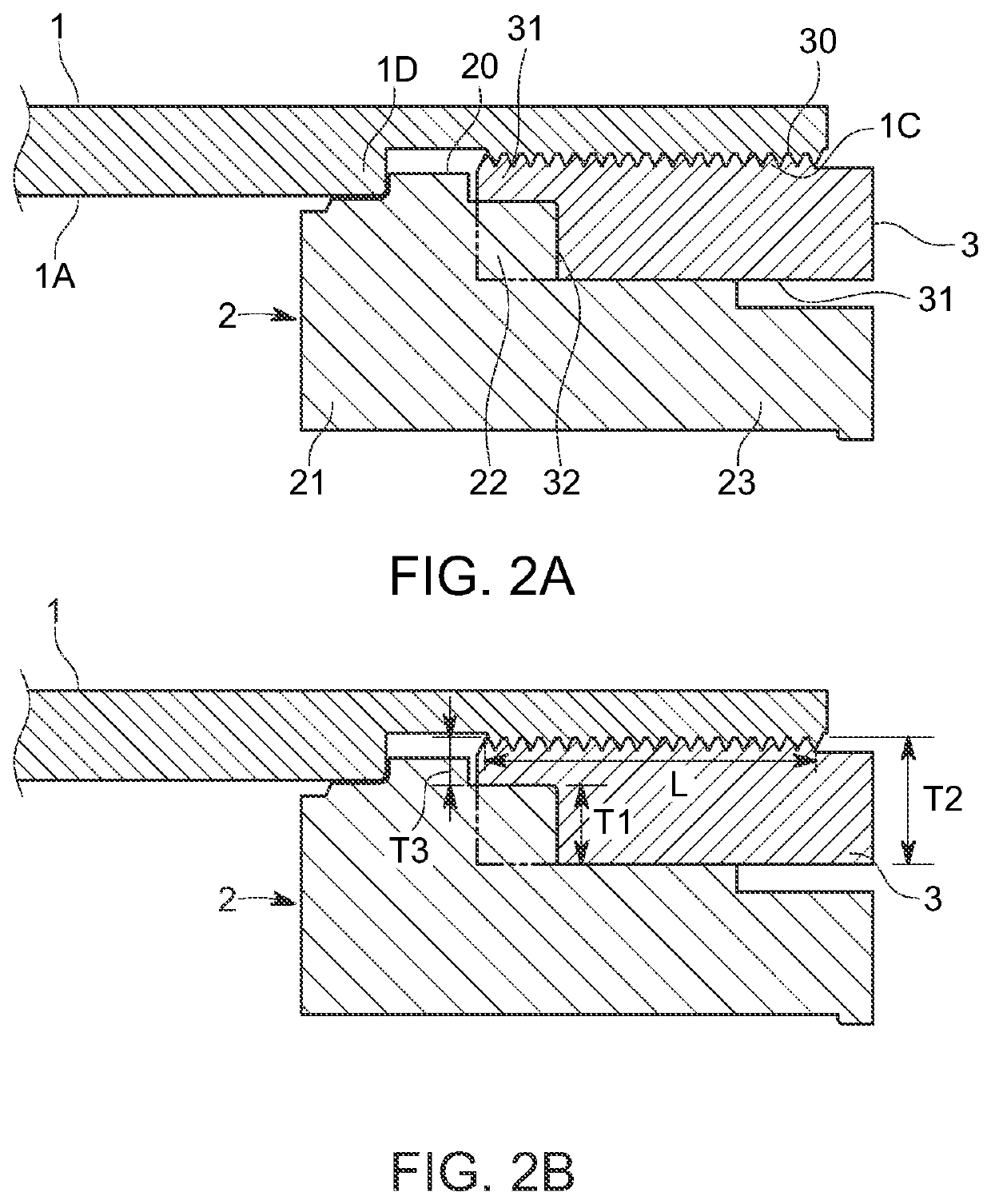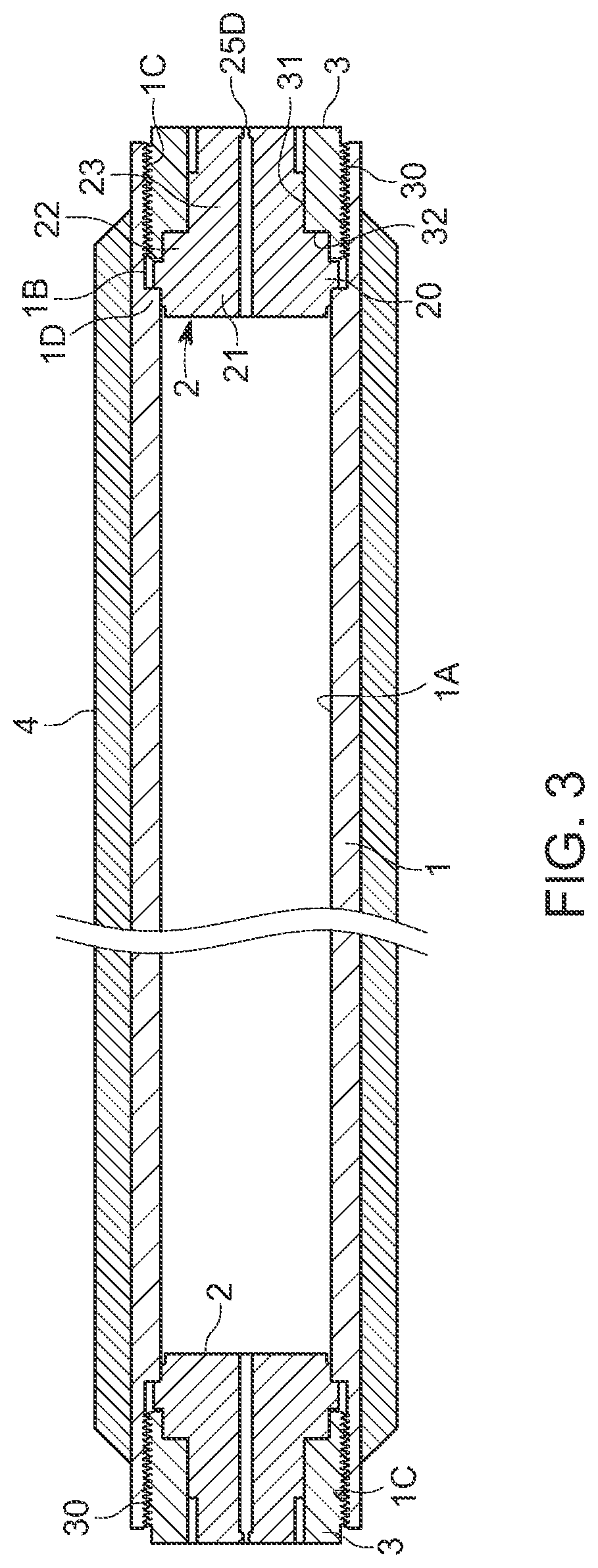Pressure accumulation container
a technology of accumulator vessel and cylinder, which is applied in the direction of container discharging methods, vessel construction details, electrochemical generators, etc., can solve the problems of vessel failure, accumulator vessel safety remarkably fail, etc., and achieve the effect of reducing the running cost of hydrogen station and accumulator vessel renewal cost, easy opening and closing of the lid at the end portion of the cylinder portion, and spreading the hydrogen society
- Summary
- Abstract
- Description
- Claims
- Application Information
AI Technical Summary
Benefits of technology
Problems solved by technology
Method used
Image
Examples
embodiment 1
[0046]An embodiment of the invention will be described as below.
[0047]A hydrogen gas accumulator vessel 10 of this embodiment has a circularly cylindrical cylinder portion 1 made of steel, lid portions 2 configured to close tightly end portions of the circularly cylindrical cylinder portion 1 in such a way as to open them as required, and screwable portions 3 where to fix the lid portions 2 in place in the circularly cylindrical cylinder portion 1. The hydrogen gas accumulator vessel 10 corresponds to an accumulator vessel of the invention. Additionally, in this embodiment, both the end portions of the circularly cylindrical cylinder portion 1 are openable and closeable end portions.
[0048]A Mannesmann-type vessel in which both end openings are tighten or an Ehrhardt-type seamless vessel (a so-called bomb) is used sometimes as a conventional hydrogen gas accumulator vessel. However, in these conventional accumulator vessels, since the opening portions are small, cracks in an inner su...
embodiment 2
[0075]As shown in FIG. 3, an outer circumferential side of a circularly cylindrical cylinder portion 1 can be hooped with a fiber reinforced plastic 4. The other configurations are remain the same as those of Embodiment 1, and like reference numerals will be given to like portions to those of Embodiment 1, omitting a repeated description thereof.
[0076]As this occurs, there is imposed no specific limitation on the types fiber or plastic material to be used in this invention. For example, carbon fiber can be used as fiber for reinforcement, and epoxy resin or the like can be used as plastic material for covering. It is desirable to use a continuous fiber as fiber for reinforcement. There is imposed no specific limitation on the thickness of fiber to be used, either, and the thickness of fiber to be used can be determined in relation to a strength required. In the invention, the outer circumferential side of the circularly cylindrical cylinder portion 1 may not be hooped with the fiber...
embodiment 3
[0079]In Embodiments 1, 2, the ligament portion and the protruding portion 22 are described as being positioned on planes that are radially almost identical, however, the ligament portion and the protruding portion 22 may be disposed so that a clear gap is defined between an outer circumferential surface of the protruding portion 22 and an inner circumferential surface of the ligament portion.
[0080]FIG. 4A shows that a ligament portion of a screwable portion 3A has a thin inner ligament portion 33A and a thick ligament portion 34A. In this embodiment, too, the protruding portion 22 can be brought into contact with a recessed portion of the screwable portion 3A. Although the ligament portion is described as having the two-staged configuration in this embodiment, the number of stages may be increased further. In addition, the ligament portion is described as having the structure in which part of the ligament portion is in contact with or lies near the protruding portion 22, however, t...
PUM
| Property | Measurement | Unit |
|---|---|---|
| stress distribution | aaaaa | aaaaa |
| surface length | aaaaa | aaaaa |
| depth | aaaaa | aaaaa |
Abstract
Description
Claims
Application Information
 Login to View More
Login to View More - R&D
- Intellectual Property
- Life Sciences
- Materials
- Tech Scout
- Unparalleled Data Quality
- Higher Quality Content
- 60% Fewer Hallucinations
Browse by: Latest US Patents, China's latest patents, Technical Efficacy Thesaurus, Application Domain, Technology Topic, Popular Technical Reports.
© 2025 PatSnap. All rights reserved.Legal|Privacy policy|Modern Slavery Act Transparency Statement|Sitemap|About US| Contact US: help@patsnap.com



